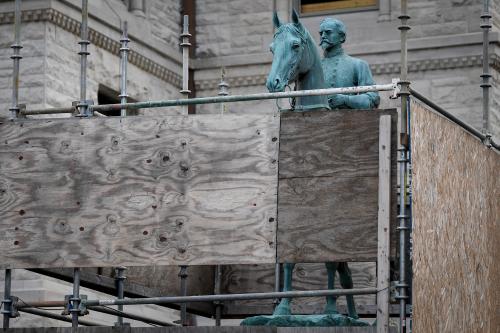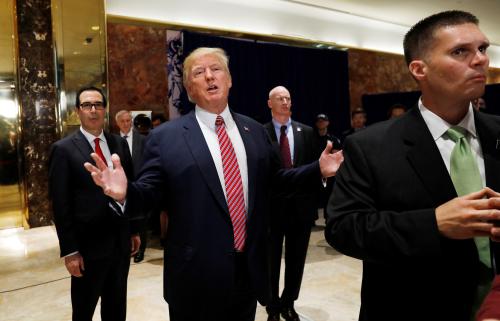“Our nation is witnessing a merciless campaign to wipe out our history, defame our heroes, erase our values, and indoctrinate our children,” Donald Trump said in his pre-Independence Day rally in front of Mount Rushmore. He reprised the same themes on the White House lawn the following day. In the midst of a national catharsis on race and social justice, in front of a monument to great American leaders, and then on the lawn of the iconic symbol of American leadership, Trump chose a dog whistle message to stoke the “us vs. them” that has become his stock in trade.
It wasn’t a new message, just new venues. At his last rally in Tulsa, Trump used similar rhetoric–“They want to demolish our heritage”–to describe the ongoing debate over removing statues to Confederate figures. This time he doubled down. In the first quote above, he made four specific assertions that he attributed to a “left-wing cultural revolution.” Let’s look at each of those claims, especially as they relate to the matter that continues to haunt the nation: the symbolism of Confederate statues and the naming of military bases for Confederate figures.
“Wipe out our history.” The statues of Confederate soldiers may be part of our history, but not in the way Donald Trump sees that history. These men were traitors, and their celebration is a reminder to Black Americans that the oppression for which they fought is still alive.
A few years ago, I was making a presentation in a former slaveholding state based on my book “Leadership Lessons of the Civil War.” When I referred to those who fought for the Confederacy as traitors, you could feel the air being sucked from the room. Afterward, some who had been in the audience confronted me over the statement.
But the judgment is unassailable. To take up arms against your country is a traitorous act. Erecting statues is just a way to obfuscate that reality while celebrating what caused it. In a similar manner, naming American military bases for generals who fought against America helps keep that traitorous tradition alive.
“Defame our heroes.” Donald Trump’s least favorite word, it would seem, is “loser.” He frequently weaponizes it against those with whom he disagrees. It is particularly strange, therefore, that the “heroes” he seeks to aggrandize are the losers of the Civil War.
The veneration of those who led the insurrection we call the Civil War is the exception to the old rule that history is written by the winners. And that was exactly why the statues were erected: to rewrite that history and send a message that the cause that drove the treason continued.
You do not find statues of Erwin Rommel in Germany. On the battlefield, he was a strategic genius on par with Confederate generals Robert E. Lee and Thomas “Stonewall” Jackson (whom he studied). Recognizing the rotten core of Nazism, Rommel participated in the attempted assassination of Hitler (which cost him his life). But statues are not erected to celebrate national shames. Even if the individual may have been a genius, using that genius for the wrong purpose is nothing to memorialize.
“Erase our values.” The values celebrated by the memorials whose loss Trump mourns are not those of bravery or strategic brilliance, but of continuing oppression. According to the American Historical Association, the Confederate monuments erected in the Jim Crow era of the late 19th and early 20th century were “part and parcel of the initiation of legally mandated segregation and widespread disenfranchisement across the South.” The monuments were symbols of white supremacy whose purpose was intimidation, a reminder that the so-called Lost Cause was not over and a reiteration of the racial oppression that it was all about.
“The Civil War wasn’t about slavery,” the refrain of Lost Cause supporters goes, “it was about states’ rights.” That “state right” was the perpetuation of human bondage.
“Indoctrinate our children.” I have written two books about the Civil War. One was about the Great Emancipator, Abraham Lincoln, the other about the battlefield leaders on both sides. Without a doubt, until President Lincoln finally found the general he deserved in Ulysses S. Grant, the South had the best battlefield leaders. Their battlefield behavior was often brilliant. The cause for which they fought, however, was despicable.
So, how do we rationalize that contradiction? It is the nuance of this conversation that our children need to understand. The purpose of history is to tell the story of previous decisions–including their imperfections–in order to inform our lives today. The tactical skills of the generals on the battlefield is worthy of study. The decision that put them on that battlefield, however, forever stains their memory.
It is history’s relevance to today that must be understood. History is the story of how humans, when confronted with challenge, acted imperfectly. It is precisely this multifaceted and imperfect history that our children should learn. We owe the next generation an appreciation of what it means for ordinary citizens to rise to hero status–as well as how to define hero status.
It was particularly telling that on his way to Mount Rushmore, Donald Trump helicoptered over Native American demonstrators. The Original Americans were protesting what was happening on their sacred land.
Had Trump truly cared about history as something more than a campaign stunt, there was another message he could have delivered. It could have been an inclusive message. It could have been a message to challenge us, rather than divide us. It could have been the story of Robert E. Lee’s surrender at Appomattox on April 9, 1865.
Accompanying General Grant was his aide, Lt. Col. Ely S. Parker, who was a Seneca Indian. When Lee entered the McLean house for the surrender, he saw Parker and commented, “I am glad to see one real American here.” Lt. Col. Parker responded, “We are all Americans.” It is a message that is as valid today as it was then, but it is lost on a man who wants to use history to divide us.







Commentary
Donald Trump fakes history in order to divide us
July 6, 2020